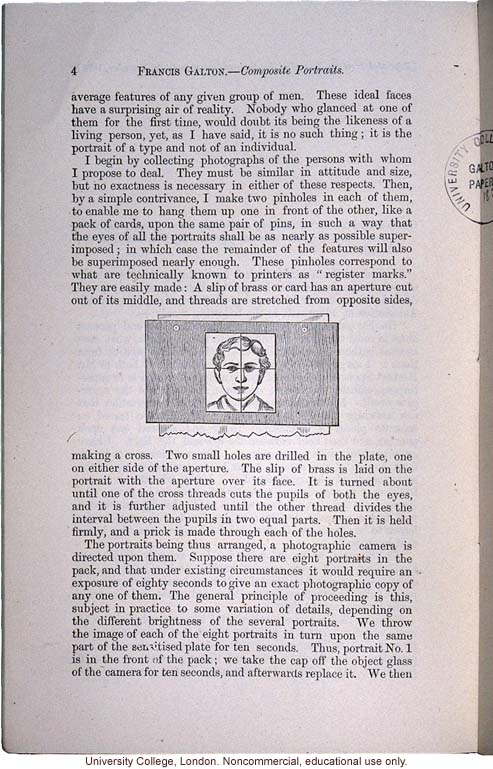4 Francis Galton. - Composite Portraits.
average features of any given group of men. These ideal faces have a surprising air of reality. Nobody who glanced at one of them for the first time, would doubt its being the likeness of a living person, yet, as I have said, it is no such thing; it is the portrait of a type and not of an individual.
I begin by collecting photographs of the persons with whom I propose to deal. They must be similar in attitude and size, but no exactness is necessary in either of these respects. Then, by a simple contrivance, I make two pinholes in each of them, to enable me to hang them up one in front of the other, like a pack of cards, upon the same pair of pins, in such a way that the eyes of all the portraits shall be as nearly as possible superimposed; in which case the remainder of the features will also be superimposed nearly enough. These pinholes correspond to what are technically known to printers as "register marks." They are easily made: A slip of brass or card has an aperture cut out of its middle, and threads are stretched from opposite sides, making a cross. Two small holes are drilled in the plate, one on either side of the aperture. The slip of brass is laid on the portrait with the aperture over its face. It is turned about until one of the cross threads cuts the pupils of both the eyes, and it is further adjusted until the other thread divides the interval between the pupils in two equal parts. Then it is held firmly, and a prick is made through each of the holes.
The portraits being thus arranged, a photographic camera is directed upon them. Suppose there are eight portraits in the pack, and that under existing circumstances it would require an exposure of eighty seconds to give an exact photographic copy of any one of them. The general principle of proceeding is this, subject in practice to some variation of details, depending on the different brightness of the several portraits. We throw the image of each of the eight portraits in turn upon the same part of the sensitised plate for ten seconds. Thus, portraits No. 1 is in the front of the pack; we take the cap off the object glass of the camera for ten seconds, and afterwards replace it. We then
[figure of portrait set in center of text]
[end]


